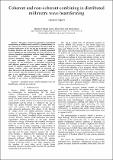JavaScript is disabled for your browser. Some features of this site may not work without it.
| dc.contributor.author | Farhana Islam, Shammi | |
| dc.contributor.author | Burr, Alister | |
| dc.contributor.author | Grace, David | |
| dc.date.accessioned | 2021-09-17T10:16:57Z | |
| dc.date.available | 2021-09-17T10:16:57Z | |
| dc.date.issued | 2019-03-10 | |
| dc.identifier.uri | http://repo.sltc.ac.lk/handle/1/105 | |
| dc.description.abstract | This paper considers the application of distributed beam forming to millimeter-wave (mm Wave) communications, in the context of 5G wireless communications. We discuss both the potential applications of 5G and the key technologies involved, including mm Wave and Massive MIMO, including distributed massive MIMO and 3D beam forming. We point out that in the context of mm Wave propagation, which is usually dominated by line-of-sight propagation over relatively short distances, distributed rather than centralized beam forming is more applicable. We then present a numerical evaluation of the performance of distributed beam forming with different numbers of access points carrying 10 10 arrays of mm Wave antenna elements, assuming that the signals combine either non-coherently or coherently. We show that even in the non-coherent case a gain is available that is greater than the increase in transmission power. This gain is very significantly increased in the coherent case. We then further discuss practical implementation issues, especially in the context of OFDM systems | en_US |
| dc.language.iso | en | en_US |
| dc.publisher | ETIC conference | en_US |
| dc.subject | Distributed massive MIMO | en_US |
| dc.subject | millimeter-wave | en_US |
| dc.subject | 3D beamforming | en_US |
| dc.subject | coherent | en_US |
| dc.subject | non-coherent | en_US |
| dc.title | Coherent and non-coherent combining in distributed millimetre wave beamforming | en_US |
| dc.type | Article | en_US |
